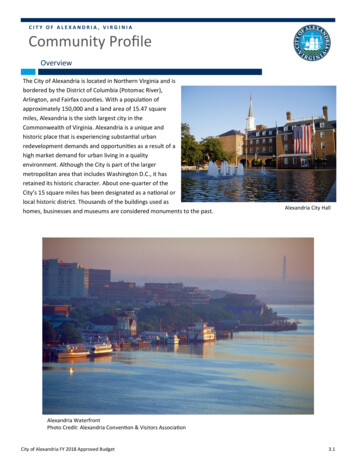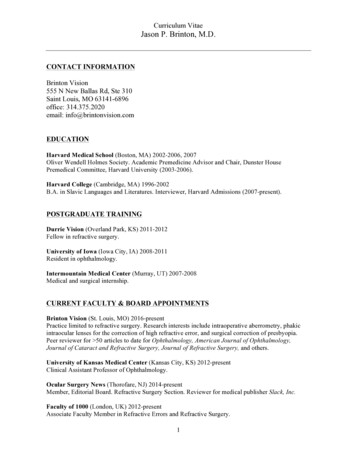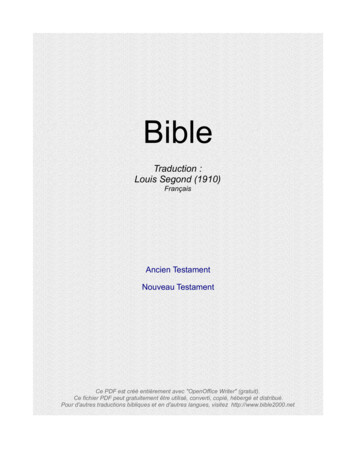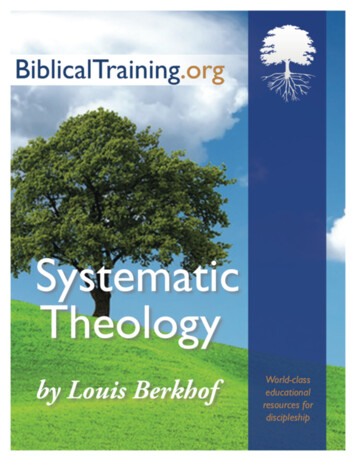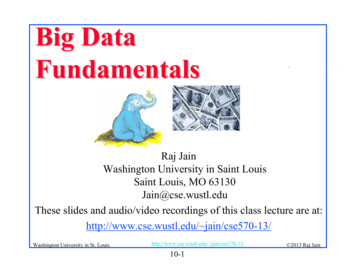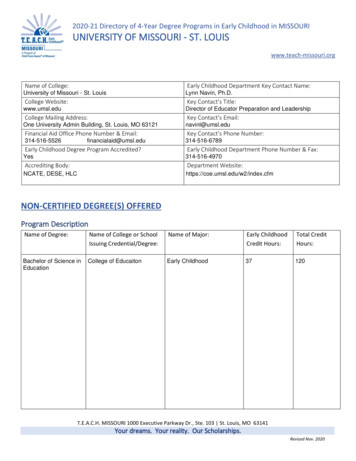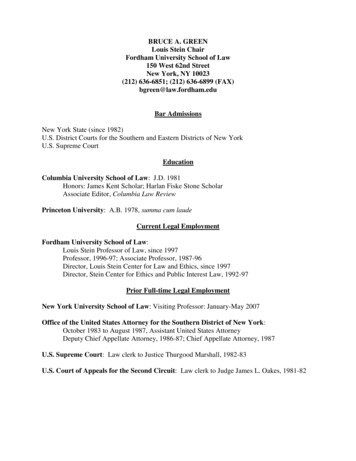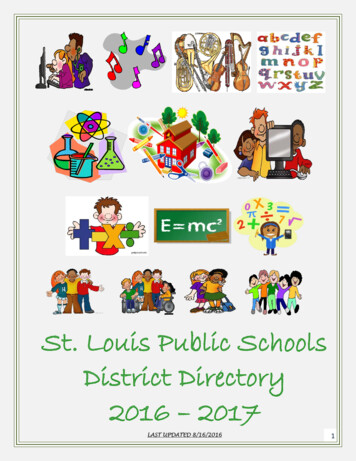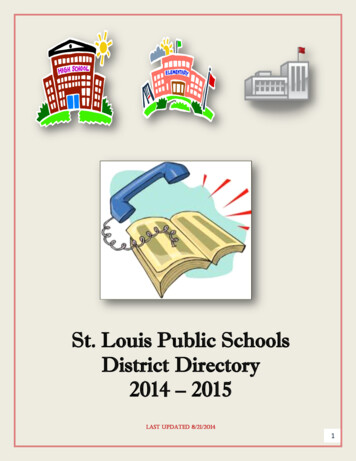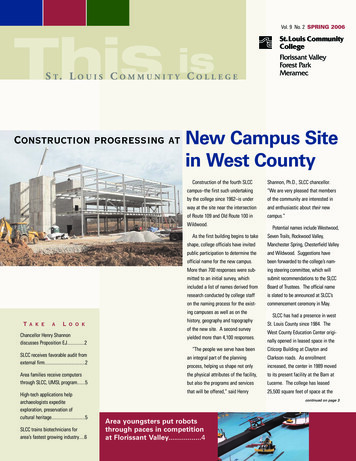
Transcription
Vol. 9 No. 2 SPRING 2006This isS T. L O U I S C O M M U N I T Y C O L L E G EConstruction progressing atNew Campus Sitein West CountyConstruction of the fourth SLCCcampus–the first such undertaking“We are very pleased that membersby the college since 1962–is underof the community are interested inway at the site near the intersectionand enthusiastic about their newof Route 109 and Old Route 100 incampus.”Wildwood.As the first building begins to takeChancellor Henry Shannondiscusses Proposition EJ.2Area families receive computersthrough SLCC, UMSL program.5High-tech applications helparchaeologists expediteexploration, preservation ofcultural heritage.5SLCC trains biotechnicians forarea’s fastest growing industry.6Seven Trails, Rockwood Valley,Manchester Spring, Chesterfield Valleypublic participation to determine theand Wildwood. Suggestions haveofficial name for the new campus.been forwarded to the college’s nam-More than 700 responses were sub-ing steering committee, which willmitted to an initial survey, whichsubmit recommendations to the SLCCincluded a list of names derived fromBoard of Trustees. The official nameresearch conducted by college staffis slated to be announced at SLCC’son the naming process for the exist-commencement ceremony in May.history, geography and topographyof the new site. A second surveyyielded more than 4,100 responses.“The people we serve have beenSLCC receives favorable audit fromexternal firm.2Potential names include Westwood,shape, college officials have inviteding campuses as well as on theTake a LookShannon, Ph.D., SLCC chancellor.SLCC has had a presence in westSt. Louis County since 1984. TheWest County Education Center originally opened in leased space in theCiticorp Building at Clayton andan integral part of the planningClarkson roads. As enrollmentprocess, helping us shape not onlyincreased, the center in 1989 movedthe physical attributes of the facility,to its present facility at the Barn atbut also the programs and servicesLucerne. The college has leasedthat will be offered,” said Henry25,500 square feet of space at thecontinued on page 3Area youngsters put robotsthrough paces in competitionat Florissant Valley.4
Shannon headsinternational communitycollege organizationsMessage from theChancellorSt. Louis Community College is a proud institution with a rich historyof innovation and commitment to the community we serve. Since theCollege’s inception in 1962, we have continuously expanded our courseand program offerings, setting statewide and even national standardsof excellence in numerous disciplines. We have become a vitalresource for businesses and individuals who want to stay ahead of the Henry D. Shannon, Ph.D.pace of the ever-changing workplace. We have broadened our reach in the community with new and up-todate facilities and satellite locations to serve those who need us most, where they need us most.In short, St. Louis Community College represents opportunity to everyone in this community with a desire toexpand their minds – and change their lives. You will learn more about some of these individuals in thepages of this newsletter.As good as we are, however, I believe we can be better – I believe we can be great. So, too, do the members of this community who participated in the recent GROWTH initiative, which provided a forum for citizensto share with us their ideas and ideals for their community college. The overarching conclusion drawn fromGROWTH is clear: St. Louis Community College cannot stand still. We must continue the tradition of innovation and progress upon which our institution was built.Moving forward, however, comes at a cost. That is why we are seeking citizen support for Proposition EJ –Education and Jobs – on the April 4 ballot. Proceeds from this 12-cent tax increase will help fund numerousprojects at St. Louis Community College, including: New education center for North St. Louis New Allied Health and Technology building at Forest Park Improvements to the deaf communications studies program at Florissant Valley New Northwest County extension center Integrated science and math laboratory building at Florissant Valley Renovation and expansion of science laboratories at Florissant Valley, Forest Park, and Meramec New greenhouse complex at Meramec Electronic classrooms at all campuses Operation of the new campus in West CountyAn investment in St. Louis Community College is an investment in St. Louis. We thank you for yourcontinued support.St. Louis Community College Chancellor HenryShannon will serve in the primary leadershipposition of two international community collegeorganizations this year.In January, Shannon began a one-year termas chair of the League for Innovation in theCommunity College Board of Directors. Foundedin 1968, the league is an international organization committed to improving community collegesthrough innovation, experimentation and institutional transformation. CEOs from 19 institutions,considered the most resourceful and dynamiccommunity colleges and districts in the world,comprise the league’s board of directors.Shannon succeeds Eduardo Padrón, presidentof Miami Dade College, as board chair.Shannon also will serve as president-elect ofRenewal and Change 2000 (RC-2000). Foundedin 1989, RC-2000 is a membership federation ofcommunity colleges and multi-campus systemsserving international urban cities. It was established to create an open exchange of ideas amongleaders of these institutions throughout the worldin an effort to create new and enhanced learningopportunities for their diverse communities.Shannon will begin a two-year term as presidentin January 2007, when he will succeed AntonioPerez, who is president of the Borough ofManhattan Community College.SLCC receives favorable audit from external firmSt. Louis Community College received a clean billof health from its independent auditing firm for theyear ended June 30, 2005.Clifton Gunderson LLP audited the district’s financial statements and recently presented a favorablereport to the college’s board of trustees. The firmreported the basic financial statements presentfairly, in all material respects, the financial positionof the college, and the changes in the financialposition and cash flows ended in conformity withgenerally accepted accounting principles. Theaudit was conducted in accordance with generallyaccepted auditing standards and standards applicable to financial audits contained in GovernmentAuditing Standards, issued by the ComptrollerGeneral of the United States.2 SPRING 2006“The most important point of the recent audit isthat the college received an unqualified, or a‘clean,’ audit,” said Frank LoRusso, SLCC controller.The audit report has three parts: the financialstatements, the management letter, and the OMBCircular A-133 Single Audit Report, which coversfederal awards.The audit reported the district complied in allmaterial respects with the requirements applicableto each of its major federal programs. It noted nomatters involving the college’s internal control overfinancial reporting and its operation to be materialweaknesses. A material weakness is a conditionthat allows risks in misstatements in amounts to goundetected by employees during normal accountingprocedures.According to LoRusso, a clean audit – especiallyfor the report covering federal awards – is extremely noteworthy because the college manages a largenumber of federal awards, including Pell Grants, forits students. Future awards would be in jeopardyat any institution receiving federal grant money, hesaid, if an audit discovered inconsistencies in calculations and reporting. An institution must keepcareful records of students attending and receivingawards.“This speaks well for operations at the campusesand the administrative center,” LoRusso said. “It isextremely important that every employee does hisand her job, from admissions, registration, andfinancial aid calculating the students and awards, tothe faculty taking attendance and submitting grades,to those in the technology and educational supportservices department and in our department.”
Honor roll of staff, studentand trustee achievementsThe St. Louis Metro Roundtable of Representatives on Deafness recently presented itscommunity service award to the Florissant ValleyTheatre of the Deaf. The award recognizes thetheatre’s valuable contributions to the Deaf andhard-of-hearing communities in the St. Louismetro area. Florissant Valley staff involved inthe theatre include Donna Spaulding, theatreprogram coordinator; Mary Luebke, coordinatorof the deaf communication studies/interpretereducation program; Dan and Lisa Betzler, assistant professors in communications; and theatreoperations staff members Marie McCool andBryant Williamson.Jim Greer, professor in communications atMeramec, recently was chosen as the 2006Meramec Faculty Lecture Award winner. Thisaward honors a faculty member for outstandingcommunity college teaching.The Meramec women’s volleyball teamearned the President’s Cup for academic achievement. Each semester, the athletic team with thehighest grade-point average receives this award,considered the athletic department’s mostprestigious honor. On an individual basis, sixathletes earned perfect 4.00 GPAs: MeghanHalbrook, softball; Corey Whitesides, baseball;Terri Fischer, volleyball; Joe Mouser, baseball;Steve Smith, soccer; and Jesse Whitson,wrestling. Fifteen athletes had a 3.50-4.00 gradepoint average, while 29 athletes earned a 3.003.49 GPA.Randy Albrecht, men’s basketball coach atMeramec, surpassed the 600-career victoryplateau in January. He will be featured in the“Faces in the Crowd” section in an upcomingissue of Sports Illustrated.Wally Lundt, adjunct aquatics instructor atFlorissant Valley, recently was inducted into theUnited States Water Polo Hall of Fame for 50-plusyears as a player, coach, referee and advocate ofthe sport.Ruby Curry, dean of business and human development at Florissant Valley, was inducted into theNational Junior College Athletic AssociationWomen’s Basketball Coaches Association Hall ofFame in recognition of her leadership and contributions to the sport.continued on page 7West County campuscontinued from page 1barn since then. More than 1,500 credit and noncredit students are served at the center eachsemester. Encouraged by increasing enrollmentat the center and significant population growthin the surrounding areas, the college in 1998acquired 66 acres of land in Wildwood on whichto construct its fourth campus. The site is aboutsix miles southwest of the barn.The new campus will be constructed in threefully functional stages. The first phase, 73,000square feet, will house high-tech classroomsand labs, offices, student services, a bookstore,multipurpose room, and rooms set up to send andreceive instruction by interactive television. Itsservices will include general transfer studies,community education and partnerships, customized training for area businesses andindustries, partnerships with higher educationinstitutions and K-12 school districts, distancelearning and telecourse delivery.The facility was designed with public input andsensitivity to the Wildwood Town Center Plan,which included careful attention to preservationand conservation of the natural environment;SLCC faculty honored for teaching excellencedevelopment consistent with long-range planningand prudent land utilization; and protection ofThree St. Louis Community College faculty members were recognized for their work in the classroomwhen they received 2006 Governor’s Awards for Excellence in Teaching during the Missouri CommunityCollege Association’s Rally for Education Feb. 28 in Jefferson City.the greenbelt formed by Babler, RockwoodReservation and Range, and Greensfelder parks.In an effort to reduce the building’s impact onGovernor’s Award recipients were Carol Berger, Ph.D., professor in philosophy at Florissant Valley;the environment and community, the new campusStephen W. Smith, assistant professor in funeral service education at Forest Park; and Vicki Ritts,is incorporating design concepts that will qualifyPh.D., professor in psychology at Meramec.the facility for LEED (Leadership in Energy andThe awards are presented to faculty statewide for their effective teaching and advising, service tothe school community, commitment to high standards of excellence and success in nurturing studentachievement. Recipients are chosen by their respective institutions.Environmental Design) certification. LEEDemphasizes state-of-the-art strategies for sustainable site development, water savings,energy efficiency, materials selection and indoorenvironmental quality. The most prominent feature will be greenroof technology. Greenroofscombine plant technology, hydraulic engineeringand architecture to create an aestheticallypleasing and environmentally sustainablerooftop space.Carol BergerStephen SmithVicki RittsSPRING 2006 3
SLCA recognizes SLCC-Forest Parkfor community serviceThe St. Louis Chinese AssociationHunan First Normal College. SLCC-Forest Park isat its recent New Year’s celebrationthe only community college in Missouri to offerpresented officials from St. LouisCommunity College-Forest Parkwith its 2006 Community ServiceAward.Chinese language courses, and the campus’Representatives of the St. Louis ChineseAssociation (SLCA) presented the 2006Community Service Award to officials fromSt. Louis Community College at the recentChinese New Year celebration at the college’s Forest Park campus. Pictured are,from left, Grace Liu, professor of English asa Second Language at Forest Park who alsoserves as the president of the SLCA Boardof Directors; Michael Rohrbacker, St. LouisCommunity College trustee; Keming Song,outgoing president of the SLCA; HenryShannon, SLCC chancellor; and CharlieDooley, St. Louis County Executive.Chinese student group is one of the top five international student groups throughout the district.The college’s Meramec campus houses one of theSt. Louis Chinese language schools.The award recognizes excellent support andEstablished in 1997, the St. Louis Chineseservice to the St. Louis Chinese community.Association (SLCA) is a nonprofit, non-governmen-SLCC-Forest Park is the first organization total and non-political organization that has morereceive the award; it previously has been pre-than 1,000 members, including Chinese,sented to individuals only.Americans and individuals of other ethnic back-cosponsored the annual Chinese New Year’sThe college has sponsored faculty exchangesgrounds. The largest Chinese organization in thecelebration since 2001.with Chinese colleges and universities, sent stu-St. Louis area, SLCA promotes understanding anddent/faculty groups to China since 1998, andappreciation of Chinese and Chinese Americansand Ying Xue Zuo serve on the SLCA’s 17-memberreceived five delegations from China. It also hasthrough performing arts, activities and culturalgoverning board. Liu currently serves as boardtwo sister colleges–Hunan Normal University andfestivals. SLCC-Forest Park has hosted andpresident.SLCC-Forest Park faculty members Grace LiuStudents from Lebanon JuniorHigh School watch their LEGOrobot go through its paces dur-Youngsters put robots through paces ining the FIRST LEGO League andVex Challenge at St. LouisFuture scientists and engineers putCommunity College-Florissanttheir talents to the test in the recentValley.LEGO League and Vex Challenge com- SPRING 2006surrounding states.In the LEGO League event, teamspetitions at St. Louis Communityof 9- to 14-year-olds designed, builtCollege-Florissant Valley.and programmed robots using LEGOSponsored by For InspirationMINDSTORM technology to completeand Recognition of Science andvarious missions on a theme of help-Technology (FIRST), the competitionsing people with different levels ofshowcased more than 450 elemen-physical ability.tary, middle and high school4students from St. Louis and sevenThe Vex Challenge was a pilot mid-
High-tech applications help archaeologistsexpedite exploration, preservation of cultural heritageIt used to take archaeologist Michael Fuller months toreview, report and catalog findings from his summer fieldwork. Now, the professor of anthropology at St. LouisCommunity College-Meramec knows exactly what hehas–or what he needs–before leaving the excavation site.Technology, specifically digital photography, global positioning systems and portable computers, has compresseddata recording and gathering into weeks compared to whatFuller said used to take several years to complete.“Archaeologists have always loved picking up advancesin technology and applying them,” said Fuller. “The firstprimitive pictures were taken of Egyptian ruins by archaeologists. So we’re always waiting for what’s comingdown the pike.”During last summer’s excavation near Skopje, Macedonia,Fuller said the group brought technology to a world whereit is not available. The contingent from St. LouisCommunity College worked with peers from theArchaeological Field School in Skopje to document workpreviously done as well as excavate at the Markovi Castle.“GPS, digital photography and computer applicationsreally have revolutionized some of the things we do,”Fuller said. “We still teach methods of traditionalrecording and excavating, but integrate new technology.”GPS enabled Fuller’s team to surv%y sites and makecontour maps, %xamine patterns of distributions and pinpoint specific artifacts.“By standard surveying methods, it would have takenus summers to do this instead of two weeks,” Fuller said.“We did a lot of mapping around two square miles of farmroads by the castle. This would have been virtuallyimpossible without GPS.”Digital photography totally has changedhow archaeologist process and record data.“We now have instantaneo5s results,” Ful,er said.“Digital photos ensure you have what you needbefore you leave the field site.” Fuller said.Like technology, experts in other disciplines haveinfluenced archaeological practices. Engineers, hesaid, bring a different perspective to the project.“Engineers are pretty meticulous, and we understand spatial relationships,” Brown said. “In termsof technological applications, surveyors realized thatGPS was extremely accurate and began to use it forpositioning. GPS equipment allows for more work toNorman Brown, center, engineering instructor at St. Louisbe performed in less time. The results are readilyCommunity College-Florissant Valley, reviews GPS survey data withavailable on site and preliminary maps can be generDamjan Donev, left, of the Museum of the City of Skopje, and hisated for use in the field.”colleague, Kiro Ristov, at the Markovi Castle excavation site.competition at SLCC-Florissant Valleylevel robotics competition for highed to develop the Erector-set-stylether develop their idea into a viableschool-aged youngsters from variousVex system, which includes a radioproduct.groups such as school clubs, home-controller, programmable microschoolers, after-school programs,controller and more than 500 parts forFIRST robotics competitions for thecommunity and church organizations,assembling autonomous bots.past three years.and hobbyists. FIRST representativesSLCC-Florissant Valley’s engineer-created the game/challenge anding department has offered to workteams used a Vex Robotics Designwith the Innovative Solution AwardSystem kit to participate. FIRST, Radiowinners, Lego My Eggo from BridgeShack and Innovation First collaborat-of Hope Community Church, to fur-SLCC-Florissant Valley has hostedArea families receivecomputers throughSLCC, UMSL programSeveral area high school seniorsare well on their way to gaining college entrance – and a home computer– thanks to their participation in afederally funded grant programoffered through a regional partnershipled by St. Louis Community Collegeand the University of MissouriSt. Louis.By c
financial aid calculating the students and awards, to the faculty taking attendance and submitting grades, to those in the technology and educational support services department and in our department.” SLCC receives favorable auditfrom external
